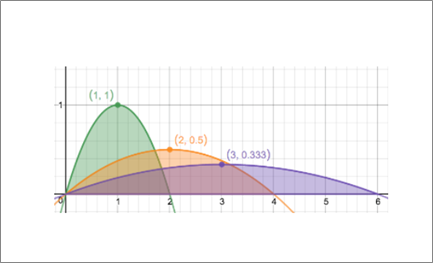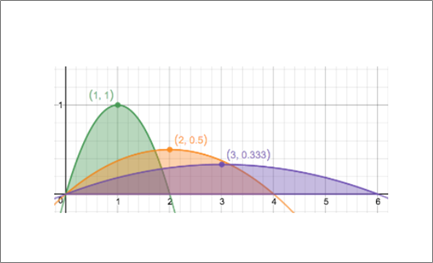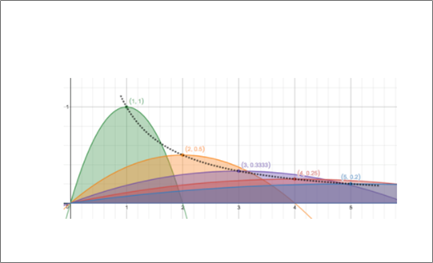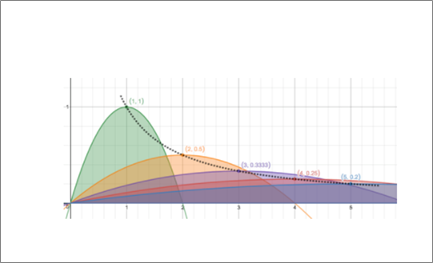
Concept explainers
a.
To graph: several members of the family of functions
a.
Answer to Problem 2P
Explanation of Solution
Given information: Given several members of the family of functions
Calculation:
Here’s a sketch for c =1 (green), c = 2 (orange),), c = 3 (purple) is given below.

Notice how the maximum width of the region is always equal to 2c and the height to
b.
To prove: conjecture in part (a).
b.
Answer to Problem 2P
Explanation of Solution
Given information:
Calculation:
Here’s a sketch for c =1 (green), c = 2 (orange),), c = 3 (purple) is given below.

First need to prove conjecture that the width of the region is always 2c .
The area of the region by integrating the function with respect to x between 0 and 2c.
Notice how c disappears from the equation and the region remains constant, as had first conjectured.
c.
To sketch: the curve traced out by the vertices (highest points) of the family of functions and finds what kind of curve this is.
c.
Answer to Problem 2P
Explanation of Solution
Given information:
Calculation:
Here’s a sketch for c =1 (green), c = 2 (orange),), c = 3 (purple) is given below.

Drawing a line over the vertices, notice that it converges towards zero as x increases, and its derivative, always negative, also converges to zero as x increases and also notice that the vertices are
d.
To find: an equation of the curve sketched in part (c).
d.
Answer to Problem 2P
Explanation of Solution
Given information:
Calculation:
Here’s a sketch for c =1 (green), c = 2 (orange),), c = 3 (purple) is given below.

The y -coordinating of the vertex by setting x = c in the original function. Hence, the vertex of
Chapter 5 Solutions
Single Variable Calculus: Concepts and Contexts, Enhanced Edition
- Use the properties of logarithms, given that In(2) = 0.6931 and In(3) = 1.0986, to approximate the logarithm. Use a calculator to confirm your approximations. (Round your answers to four decimal places.) (a) In(0.75) (b) In(24) (c) In(18) 1 (d) In ≈ 2 72arrow_forwardFind the indefinite integral. (Remember the constant of integration.) √tan(8x) tan(8x) sec²(8x) dxarrow_forwardFind the indefinite integral by making a change of variables. (Remember the constant of integration.) √(x+4) 4)√6-x dxarrow_forward
- a -> f(x) = f(x) = [x] show that whether f is continuous function or not(by using theorem) Muslim_mathsarrow_forwardUse Green's Theorem to evaluate F. dr, where F = (√+4y, 2x + √√) and C consists of the arc of the curve y = 4x - x² from (0,0) to (4,0) and the line segment from (4,0) to (0,0).arrow_forwardEvaluate F. dr where F(x, y, z) = (2yz cos(xyz), 2xzcos(xyz), 2xy cos(xyz)) and C is the line π 1 1 segment starting at the point (8, ' and ending at the point (3, 2 3'6arrow_forward
- I need help in ensuring that I explain it propleryy in the simplifest way as possiblearrow_forwardI need help making sure that I explain this part accutartly.arrow_forwardPlease help me with this question as I want to know how can I perform the partial fraction decompostion on this alebgric equation to find the time-domain of y(t)arrow_forward
 Calculus: Early TranscendentalsCalculusISBN:9781285741550Author:James StewartPublisher:Cengage Learning
Calculus: Early TranscendentalsCalculusISBN:9781285741550Author:James StewartPublisher:Cengage Learning Thomas' Calculus (14th Edition)CalculusISBN:9780134438986Author:Joel R. Hass, Christopher E. Heil, Maurice D. WeirPublisher:PEARSON
Thomas' Calculus (14th Edition)CalculusISBN:9780134438986Author:Joel R. Hass, Christopher E. Heil, Maurice D. WeirPublisher:PEARSON Calculus: Early Transcendentals (3rd Edition)CalculusISBN:9780134763644Author:William L. Briggs, Lyle Cochran, Bernard Gillett, Eric SchulzPublisher:PEARSON
Calculus: Early Transcendentals (3rd Edition)CalculusISBN:9780134763644Author:William L. Briggs, Lyle Cochran, Bernard Gillett, Eric SchulzPublisher:PEARSON Calculus: Early TranscendentalsCalculusISBN:9781319050740Author:Jon Rogawski, Colin Adams, Robert FranzosaPublisher:W. H. Freeman
Calculus: Early TranscendentalsCalculusISBN:9781319050740Author:Jon Rogawski, Colin Adams, Robert FranzosaPublisher:W. H. Freeman
 Calculus: Early Transcendental FunctionsCalculusISBN:9781337552516Author:Ron Larson, Bruce H. EdwardsPublisher:Cengage Learning
Calculus: Early Transcendental FunctionsCalculusISBN:9781337552516Author:Ron Larson, Bruce H. EdwardsPublisher:Cengage Learning





